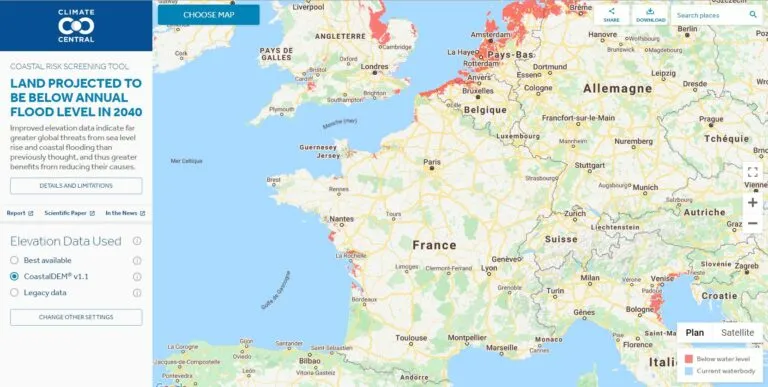The Ocean and the Climate 4mn
Rising sea levels in France in 2040
The rise in ocean temperature and the melting of ice is causing the average sea level to rise. How high will the sea level rise in France in 2040?

Climate change and rising sea levels
From the surface to the deepest depths of the sea, the ocean is getting warmer. This rise in ocean temperatures combined with the melting of the ice is causing the average sea level to rise. How high will sea levels rise in France in 2040?
The report by the IPCC - Intergovernmental Panel on Climate Change – on the ocean and cryosphere, published in 2019, draws everyone's attention to the effects of rising sea levels that are already being felt in many parts of the world. The safety of coastal populations is directly connected to the state of the ocean.
Rapidly rising sea levels and the frequency of severe storms are threatening millions of lives, the livelihoods of many people and billions of dollars' worth of coastal infrastructure.
Coastal erosion is accentuated and the risk of flooding or flood waves along the shoreline is increasing. One of the effects of rising sea levels is that salt water penetrates inland, affecting groundwater (sources of drinking water) and irrigation water.
Rising sea levels in France in 2040
With more than 5,800 kilometres of coastline around mainland France, to which must be added almost 1,200 kilometres of coastline in the overseas departments, France, where one and a half million people live in coastal areas that are potentially exposed to the risk of marine submersion, will be inexorably impacted by rising sea levels.
The situation along the French coastline
In 2019, the website of the Climate Central programme published interactive maps offering a local assessment of the impact of rising sea levels on the coastline in 2040.
These maps are based on different scenarios of rising sea levels in relation to increasing global temperatures. The risks would be particularly high along the Atlantic coastline: Nouvelle-Aquitaine (Charente-Maritime and Gironde) as well as in the Pays de la Loire region (Loire-Atlantique and Vendée) and Brittany (Brest), and in the Pas-de-Calais, Somme and Nord departments of the Hauts-de-France region. The coasts of the Mediterranean Sea would also suffer the consequences of sea levels rising across the planet. In general, Europe and the European and French islands would be severely impacted.
On the 30th of April 2022, the French government published the list of municipalities that will have to make adapting to coastal erosion a priority due to climate change. The names of 864 communes exposed to coastal flooding appear on the list published in the Journal Officiel, and 126 municipalities are listed as having priority as regards these risks.

Why are the sea levels rising?
A WARMER OCEAN…
The ocean, which has already absorbed 93% of the excess heat from global climate change, is getting warmer at all depths, with regional variations.
This phenomenon will continue throughout the 21st century and for several centuries to come.
For example, the Pacific Northwest saw its temperature rise by more than 6°C between 2013 and 2015. As the sea warms, it expands, taking up more space and rising in level.
… MELTING ICE…
In addition to this, there is water from melting land glaciers, Greenland ice and the Antarctic polar ice cap. Rising air and ocean temperatures can rapidly melt large areas of ice in the polar regions.
The ice covering Greenland and the Antarctic continent is disappearing and the meltwater eventually finds its way into the sea.
Between 2006 and 2015, the polar ice caps lost about 433 billion metric tons/year.
AND THE OCEAN IS RISING…
Across the globe, the average ocean level has risen by 17 cm in a century, at an average rate of 1.4 mm per year. However, the rate of rise has accelerated in more recent periods: scientists estimate that since the 1990s, the ocean has risen by 8.5 cm, i.e. at an average rate of more than 3.6 mm/year. This rise in sea level is expected to continue and speed up in the coming centuries.
Sea levels could rise by 1.5 cm per year, with a global rise of 110 cm by the end of the century, thereby threatening many coastal and low-lying areas.
Roughly 28% of the world's population, or 1.9 billion people, live within 100 km of the coast and less than 100 m above sea level. Half of the world's major cities are located on the coast and are particularly at risk, as are islands, estuaries and delta areas.



